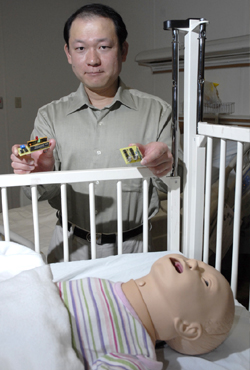RE:
SEARCH
Cradle of ingenuity
Wireless sensors aim to prevent sudden infant death syndrome

Researchers have developed a wireless monitoring system that detects carbon dioxide levels near a baby's crib.
Tiny monitors about the size of a pencil eraser may soon help new parents protect their infants from a silent killer-sudden infant death syndrome.
UT Arlington doctoral student Lun-Chen Hsu, working with electrical engineering Associate Professor J.C. Chiao, has developed the wireless sensors, which detect levels of carbon dioxide. Originally, the pair saw the sensors as tools to detect gas emitted by automobiles. They believed their work would find favor in the automotive industry.
However, Hsu soon realized that potential applications may be much broader. In collaboration with the UT Arlington School of Nursing, the engineers now see the possibility for clinical applications like monitoring infants and helping patients with a variety of pulmonary and other medical problems.
Although SIDS deaths in the United States have steadily decreased the past 20 years, the syndrome is still responsible for roughly 50 deaths per 100,000 births. It remains the No. 1 killer of infants beyond the first 30 days after birth.
Experts believe that multiple, interacting factors contribute to SIDS. And while home monitoring systems are controversial among some medical professionals, others believe that a system like that under development by Hsu and Dr. Chiao offers a real step forward.
Significant pauses in breathing are believed to be a precursor to SIDS, but most previously used monitors were designed to be attached to the infant by lead wires. Such systems are bulky, inconvenient and often too sensitive or not sensitive enough to breathing patterns. Hsu's sensors would be embedded along all four sides of a baby's crib, providing a noninvasive monitoring system with no fumbling and no forgetting.
"Parents may not feel comfortable putting wired sensors on their baby," Chiao said. "We have tried to find a noninvasive way to accomplish the task of monitoring with these sensors embedded in the crib itself."
The system monitors the exhaled air from an infant remotely.
"Due to the variation in the exhaled carbon dioxide concentration, we can quickly detect problematic episodes associated with an infant's respiration," Hsu explained.
The sensors mounted around the crib are wirelessly connected to a circuit board that includes an alarm. The circuit board can also connect to a computer to automatically record the data.
"With SIDS, infants typically don't have any identifiable traumatic symptoms," Chiao said. "Caregivers usually have no simple way of knowing precisely when it happens. The child appears healthy, then something goes wrong."
However, some infants are considered "at risk" and are logical candidates for Hsu's system.
Remote sensors must detect when an infant stops breathing for a certain period of time and transmit warning signals wirelessly so a caregiver can rush to the crib. When combined with a conventional monitoring system that transmits sounds from the infant's room, the wireless carbon dioxide monitors give parents additional protection for their child.
So the plan is scientifically sound from an engineering perspective. Now the researchers must make it work. They've built a prototype and tested it in the lab under controlled environments. Graduate students placed the sensors around their beds and held their breath. From two to five seconds later, the wireless communication triggered the alarm.
"We asked ourselves, ‘How can we put this into a real environment and test it accurately?' " Chiao said. "That's when we formed our partnership with the School of Nursing."
First, studies will be performed with healthy babies. "We especially want to reduce false alarms so that parents don't become desensitized," Hsu said.
Then the system will be tested in more detail using manikins in the School of Nursing's Smart Hospital. These patient simulators can be programmed to breathe in a variety of ways to test the sensors in real-life situations. Chiao's research group is collaborating with several nursing professors, including Judy LeFlore and Carolyn Cason.
In addition to its noninvasive features, price is another attraction of Hsu's system. At about $20 for every five sensors, it is cost effective.
"Losing a child-that's a great loss not just for parents or family but for our whole society," Chiao said. "If we can prevent those losses at such a reasonable cost, we must."
That reasonable cost may translate to assistance with other medical conditions as well. Hsu and Chiao envision the sensors helping patients with sleep disorders, asthma and other lung diseases. And testing is under way to apply similar technology as implanted sensors to detect acid reflux disease. In some cases, the sensors may be integrated with RFID (radio frequency identification) in hospitals to monitor a large number of patients and notify doctors and nurses which one needs assistance.
"We think this application may spin off into many areas and help many patients," Chiao said. "Along with the School of Nursing, we are very enthusiastic about the idea."
— Sherry W. Neaves
Other Stories
Former cadets Irish, Schneider join military hall
Mavericks Personified: The 440 Alliance
Innovative band of alumni disturbs the peace with 16 strings (and drums)
Cradle of ingenuity
Wireless sensors aim to prevent sudden infant death syndrome
Strokes of genius
Golf team earns first top-20 ranking after record-setting fall season
Computer evolution
University’s early models contained no data storage devices
Contact Us
Office of University Publications
502 S. Cooper St.279 Fine Arts Building
Box 19647
Arlington, TX 76019-0647
